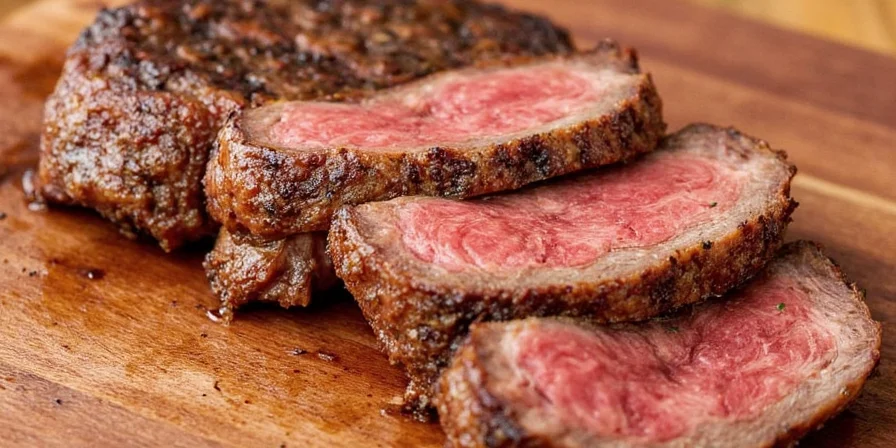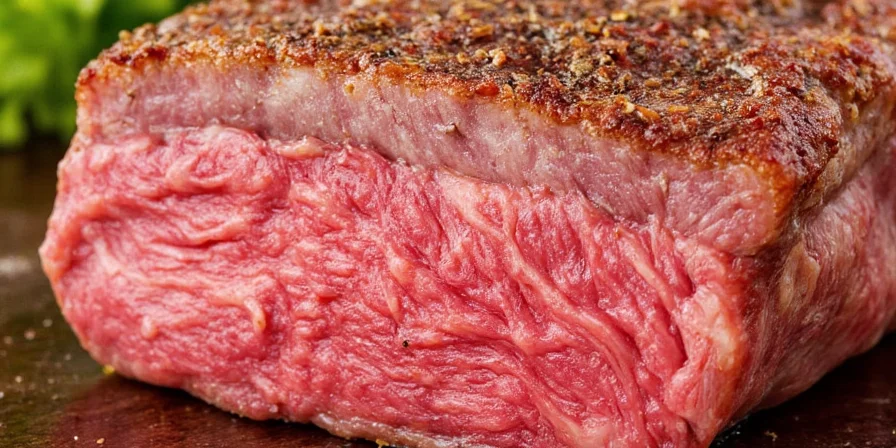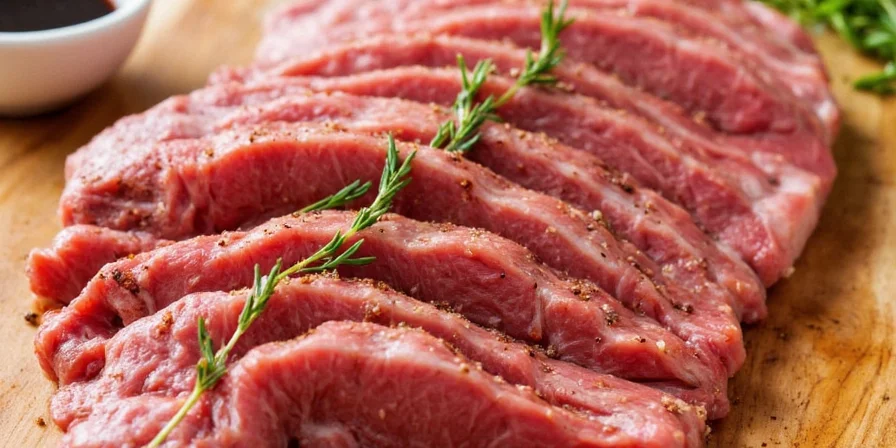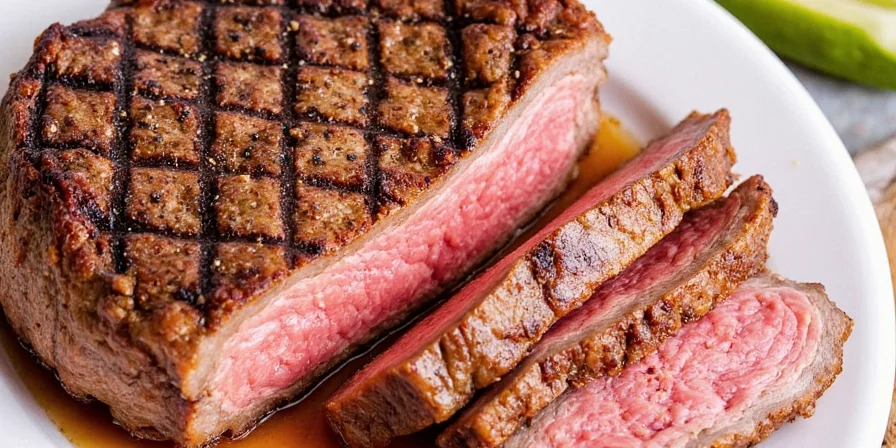The perfect steak seasoning method: Generously coat both sides with kosher salt (about 1/2 tsp per side for a 1-inch steak) 45 minutes before cooking, add freshly cracked black pepper right before cooking, and let rest 5-10 minutes after cooking. This simple approach creates maximum flavor with a perfect crust while keeping the interior juicy.
Whether you're a beginner or experienced griller, this science-based steak seasoning guide delivers restaurant-quality results at home. You'll discover precise timing techniques, salt chemistry insights, and global spice applications that transform ordinary steak into extraordinary meals.
Table of Contents
- The Magic of Salt: The MVP of Steak Seasoning
- Pepper Power: Not Just for Flavor
- Beyond the Basics: Adding Depth with Additional Spices
- Global Steak Seasoning Traditions: Cultural Flavor Science
- When to Season: Timing Is Everything
- Rub vs. Dry Brine: What's the Difference?
- The Secret Sauce: Resting Your Steak
- Steak Flavor Profile Chart
- Final Thoughts: Season Like a Pro
- Frequently Asked Questions

Properly seasoned steak before cooking showing optimal salt and pepper distribution.
The Magic of Salt: The MVP of Steak Seasoning
Salt isn't just a seasoning—it's a transformative ingredient that enhances flavor, draws out moisture (creating that beautiful crust), and when used correctly, slightly tenderizes the meat.Types of Salt for Steak
- Kosher salt: Our top recommendation for steak seasoning due to its coarse texture and clean taste that adheres well to meat surfaces.
- Sea salt: Adds a gourmet touch, especially flaky varieties like Maldon that create delightful texture contrasts.
- Pickling salt: Ideal for dry brines because it dissolves more evenly without anti-caking agents.
How Much Salt Should You Use?
As a precise guideline based on steak thickness:- For a 1-inch thick steak: ½ tsp per side
- For 1.5-inch thick steak: ¾ tsp per side
- For thick cuts (like tomahawk): 1 tsp per side

Different salts create different textures and flavor release rates—choose based on your cooking method.
Pepper Power: Not Just for Flavor
Black pepper brings earthiness and complexity to your steak. Freshly cracked pepper has significantly more aroma and potency than pre-ground varieties due to essential oil release.Why Freshly Cracked Pepper Matters
- Releases volatile compounds that enhance aroma
- Adds textural contrast to the crust
- Complements Maillard reaction during searing
Critical Timing Tip:
Apply pepper within 5 minutes of cooking start—adding it too early causes burning and bitterness, especially with high-heat methods like grilling or cast iron searing.Beyond the Basics: Adding Depth with Additional Spices
While salt and pepper form the foundation, strategic spice additions create dimension in your steak's flavor profile.Recommended Steak Seasoning Add-ins
| Spice | Flavor Contribution | Ideal Steak Pairing |
|---|---|---|
| Paprika (smoked) | Earthy smokiness | Ribeye, chuck eye |
| Garlic powder | Umami depth | NY Strip, sirloin |
| Onion powder | Sweet complexity | All steak types |
| Chili powder | Warm heat | Skirt, flank, hanger |
| Cumin | Earthy warmth | Flank, skirt for fajitas |

Strategic spice combinations elevate steak from simple to spectacular—measure precisely for balanced flavor.
Global Steak Seasoning Traditions: Cultural Flavor Science
Professional steak seasoning techniques vary globally with scientific precision:- Japanese approach: Coarse sea salt with yuzu zest balances richness while amplifying umami without masking beef's natural flavors
- Argentinian asado: Salt applied after cooking preserves moisture chemistry while creating textural contrast
- Korean bulgogi: Soy sauce's sodium content lowers water activity, enabling deeper penetration of garlic and sesame oil compounds
When to Season: Timing Is Everything
Timing dramatically affects your steak's final texture and flavor:- Quick seasoning: Salt and pepper immediately before cooking creates instant sizzle and crust formation
- Dry brine: Salt applied 45-60 minutes before cooking (for 1-1.5" steaks) allows deeper penetration and better browning
- Extended dry brine: For thick cuts (2"+), refrigerate uncovered with salt for 12-24 hours
Pro Timing Guide:
- Thin cuts (<1 inch): Quick season immediately before cooking
- Standard cuts (1-1.5 inches): Dry brine 45-60 minutes before cooking
- Thick cuts (>1.5 inches): Dry brine 12-24 hours before cooking
Rub vs. Dry Brine: What's the Difference?
Understanding these techniques prevents common seasoning mistakes:| Method | Best For | Critical Timing | Texture Result |
|---|---|---|---|
| Dry Brine | Salt-only application | 45 min-24 hours before cooking | Even salinity, superior crust |
| Spice Rub | Salt + other spices | Immediately before cooking | Complex crust, bold flavors |
Professional Flavor Layering Technique
Combine both methods: dry brine with salt first (45+ minutes pre-cook), then apply pepper and other spices right before cooking for maximum flavor dimension.
Perfect seasoning application shows even coverage without clumping for consistent flavor development.
The Secret Sauce: Resting Your Steak
Resting is non-negotiable for juicy results—scientifically proven to redistribute juices throughout the meat.Precise Resting Guidelines
- Sirloin, flank, skirt (thin cuts): 5-7 minutes
- NY Strip, ribeye (standard cuts): 8-12 minutes
- Tomahawk, thick ribeye (large cuts): 12-15 minutes
Resting Best Practices
- Loosely tent with foil—not tight, or it will steam and soften the crust
- Place on wire rack instead of cutting board to prevent soggy bottom
- Rest at room temperature—never in refrigerator
Steak Flavor Profile Optimization Chart
Match your cut with the scientifically optimized seasoning approach:| Steak Cut | Natural Flavor Profile | Optimal Seasoning Formula |
|---|---|---|
| Filet Mignon | Tender, mild beef flavor | Coarse salt 45 min pre-cook + fresh pepper + rosemary (¼ tsp) |
| NY Strip | Bold, beefy | Dry brine + garlic powder (⅛ tsp) + chili flakes (dash) |
| Ribeye | Rich, fatty | Coarse salt 60 min pre-cook + black pepper + smoked paprika (⅛ tsp) |
| Skirt Steak | Intense, chewy | Lime zest (½ tsp) + cumin (¼ tsp) + coriander (⅛ tsp) applied pre-cook |
| Flank Steak | Firm, lean | Onion powder (⅛ tsp) + oregano (⅛ tsp) + jalapeño powder (dash) |
Final Thoughts: Season Like a Pro
Mastering steak seasoning requires understanding these evidence-based principles:- Salt is transformative: Use quality salt with precise timing based on steak thickness
- Pepper timing is critical: Always crack fresh and apply within 5 minutes of cooking
- Dry brine beats rub for salt: Salt needs time to work while spices burn if applied too early
- Resting is non-negotiable: Skipping this loses up to 20% more juice
- Match seasoning to cut: Different steaks need different approaches for optimal results

Perfectly seasoned steak showing ideal crust development and interior juiciness from proper resting.
Frequently Asked Questions
How long should I dry brine a steak before cooking?
For optimal results, dry brine steaks 45 minutes to 24 hours refrigerated uncovered. Standard cuts (1-1.5 inches) need 45-60 minutes, while thick cuts (1.5+ inches) benefit from 12-24 hours. This allows salt penetration without excessive moisture loss, creating superior crust formation.
Can table salt be used for steak seasoning?
Yes, but adjust measurements. Table salt's fine grains dissolve faster and taste saltier by volume. Use 30-50% less than kosher salt measurements. Ideal for dry brines due to quick dissolution, but may create uneven crust in rubs. For 1-inch steak, use ¼ tsp per side instead of ½ tsp with kosher salt.
Why does pepper burn during high-heat cooking?
Pepper's essential oils vaporize at 400°F (204°C), causing bitterness. Apply pepper within 5 minutes of cooking start for grilling or pan-searing. For sous vide or low-temp methods, add pepper during final sear only. Never mix pepper with salt during dry brining as it will burn during cooking.
Does resting steak really make it juicier?
Yes, resting scientifically redistributes juices throughout the meat. Cutting immediately causes 15-20% more juice loss. Resting 5-15 minutes (based on thickness) allows muscle fibers to reabsorb fluids, yielding up to 30% juicier results. Use a digital thermometer to determine precise resting time—rest until internal temperature drops 5-10°F from target.
Which steak cut requires the simplest seasoning?
Ribeye needs minimal enhancement due to its high marbling. Coarse salt applied 45-60 minutes pre-cook and freshly cracked pepper immediately before searing preserves its natural beefiness. Avoid overpowering spices that mask the fat's flavor complexity. For premium ribeyes, salt only can be preferable to let the beef flavor shine.











 浙公网安备
33010002000092号
浙公网安备
33010002000092号 浙B2-20120091-4
浙B2-20120091-4